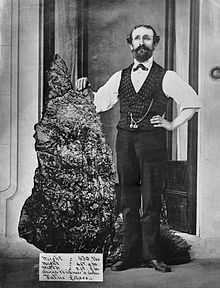Hill End, New South Wales
| Hill End New South Wales | |
|---|---|
|
Hill End, 2014 | |
 Hill End | |
| Coordinates | 33°02′0″S 149°25′0″E / 33.03333°S 149.41667°ECoordinates: 33°02′0″S 149°25′0″E / 33.03333°S 149.41667°E |
| Population | 166 (2006 census)[1] |
| Postcode(s) | 2850 |
| Location | |
| LGA(s) | Bathurst Regional Council |
Hill End is a former gold mining town in New South Wales, Australia, in Bathurst Regional Council.
History
Gold rush

Hill End owes its existence to the New South Wales gold rush of the 1850s, and at its peak in the early 1870s it had a population estimated at 8,000 served by two newspapers, five banks, eight churches, and twenty-eight pubs. Its decline when the gold gave out was dramatic: by 1945 the population was 700. At the 2006 census, Hill End had a population of 166 people.[1]
The photographer Beaufoy Merlin recorded daily life in the town at its peak; his photographs can be found in the town museum/visitor information centre. The glass plate negatives are held in the State Library of New South Wales.
Hill End artists colony
In the late 1940s Hill End was discovered by artists Russell Drysdale—who painted possibly his best-known work, The cricketers here—and Donald Friend, and quickly became an artists' colony. Other artists who worked there included Jean Bellette.[2] Today, the Hill End artist-in-residence program aims to ensure the continuity of this connection.
Hill End today

Hill End is classified as a historical site by the National Parks and Wildlife Service (NPWS), however it is still home to a handful of residents operating the local pub, general store, cake store and antique store. The National Parks and Wildlife Service runs a museum just off the main road which contains many original photos and items of equipment from the busy days of the gold rush.
NPWS has installed signs around the town to give visitors an idea of what was once in place on the now empty lots of land. Currently only a handful of buildings remain in their original form. However most of those buildings still serve the purpose they did back during the gold rush. Access to the town's lookouts is via gravel roads. A walking track in the town leads to a mine and other ruins.
The most popular tourist activity in Hill End is gold panning, with some of the older members of the community running gold panning tours in the same fossicking areas that yielded the gold which brought on the gold rush. Metal detectors or gold panning are not allowed within the historic site, however there is a fossicking area just past the cemetery, off the Mudgee Road.
The Royal Hotel and the local Bed and Breakfasts offer accommodation, and there is a range of camping options within the town limits.
Bridle Track
The Bridle Track runs from Duramana (North of Bathurst) directly to the town centre of Hill End. Generally the track can be classified as an easy 4WD track. The Bridle Track begins as a narrow tar-covered road, however it later changes to dirt. Much of the last 20 kilometres (12 mi) is single-lane.
-

Entrance to the Bridle Track from Hill End
-

Original Bridle Track Hill End
Access
- From Sofala, New South Wales which is ~ 38 kilometres (24 mi).
- From Mudgee which is around 75 kilometres (47 mi) and the route passes through Hargraves.
- From Bathurst, New South Wales via Turondale is around 75 kilometres (47 mi).
Camping
- The New South Wales National Parks and Wildlife Service (NPWS) provides several camping sites[3]
Notable People
- Selina Sarah Elizabeth Anderson (1878-1964), parliamentary candidate. [4]
See also
References
- ↑ 1.0 1.1 Australian Bureau of Statistics (25 October 2007). "Hill End (State Suburb)". 2006 Census QuickStats. Retrieved 7 October 2009.
- ↑ Gray, Anne (2010). "Jean Bellette – Chorus without Iphigenia". Collection search (work purchased 1976). National Gallery of Australia. Retrieved 8 June 2014.
- ↑ New South Wales National Parks and Wildlife Service
- ↑ "Anderson, Selina Sarah (Senie) (1878–1964)". Australian Dictionary of Biography. 2005. Retrieved 30 March 2015.
External links
![]() Media related to Hill End, New South Wales at Wikimedia Commons
Media related to Hill End, New South Wales at Wikimedia Commons